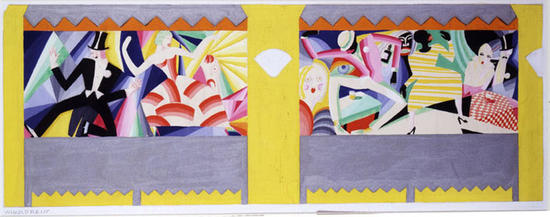Goals and Trajectory
The international symposium brings together scholars of the humanities - from both sides of the Atlantic - for the first-ever conference dedicated to the art of Winold Reiss (1886-1953) honoring the 125th anniversary of his birth. This extremely versatile German-American painter, designer, and teacher had once been celebrated by Du Pont Magazine (March 1931) as a "modern Cellini." In the 1920s and 1930s, Reiss emerged as an influential figure in transatlantic encounters and modernist aesthetics. Recognized for his portraiture and commercial-design work, he was also much in demand for the elaborate mosaics he created for restaurants and other public buildings, including the Union Terminal in Cincinnati, Ohio. Reiss collaborated with leading artists and intellectuals including Alain Locke, Katherine Anne Porter, Paul Kellogg, Miguel Covarrubias, and Langston Hughes. Among his students was Aaron Douglas, the key African-American figure in the visual Harlem Renaissance. Reiss was also the main contributor to the visual narrative of the anthology The New Negro (1925).
Cultural Mobility and Transcultural Confrontations: Winold Reiss as a Paradigm of Transnational Studies will rethink Reiss' role in the visual representation of ethnic American identities during the first half of the 20th century. A German element is woven into the fabric of his complex engagement with American ethnicity and with racial conflicts - the European artistic background he brought to the American scene demands a specifially interdisciplinary and international perspective. The symposium will examine this perspective, exploring aspects and processes of international exchange, intercultural translation, and transcultural confrontations.
The symposium will focus on the following topics:
- Re-discovering the life and work of Winold Reiss on both sides of the Atlantic. This project hopes to establish Reiss as a central figure working in the interwoven tensions of ethnicity, modernity, and modernism.
- Examining questions of cultural mobility (in the sense of Stephen Greenblatt) and transcultural confrontations as a key to understanding, decoding, and re-evaluating the complex oeuvre of Winold Reiss.
- Questioning the institutional powers and aesthetic premises at work in the reception process of Winold Reiss’s oeuvre. The conference will attempt to explore the reasons behind Winold Reiss"s relegation to the footnotes of American art history.
The John F. Kennedy-Institute for North American studies, with its interdisciplinary focus on intercultural exchange, is an ideal venue for a symposium dedicated to fhe rethinking - and establishing - Winold Reiss as an exemplar of transnational studies.

W. Reiss, Study for a Restaurant Mural. 9.5" x 24", tempera on paper, n. d. Reiss Archives.

